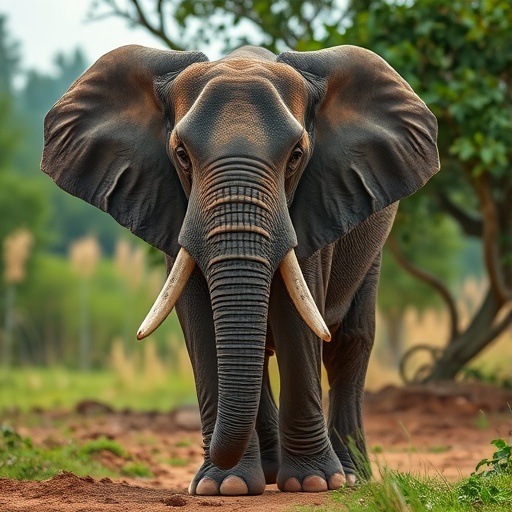With their enormous flapping ears and iconic elongated trunks, elephants have long been thought to primarily rely on acoustic and olfactory signals to navigate and communicate within their environment. Their gestures and visually mediated interactions have historically been undervalued, chiefly because the bulk of visual communication studies has centered on species like nonhuman primates, who are predominantly reliant on sight for social interactions. However, recent investigations have started to challenge this perception, revealing that elephants possess a more nuanced understanding of visual cues than previously appreciated.
A pivotal study had already established that African savanna elephants could discern human visual attention by interpreting cues from a person’s facial expressions and body orientation. Yet whether their Asian elephant cousins—who diverged from African elephants millennia ago and demonstrate notable behavioral and cognitive differences—shared this capacity remained an open question. Researchers from Kyoto University sought to fill this knowledge gap by conducting meticulous fieldwork with captive Asian elephants in northern Thailand.
The team’s lead investigator, Hoi-Lam Jim, who had previously explored how elephants form reputations, was particularly intrigued by whether Asian elephants could gauge human attentional states through visual signals. To probe this, the researchers designed a controlled food-request paradigm involving ten female Asian elephants housed in Chiang Rai. During the trials, the experimenter manipulated her physical orientation relative to the elephant, presenting one of four configurations: both face and body directed towards the elephant, both turned away, face oriented towards but body turned away, and vice versa.
By carefully monitoring and quantifying the elephants’ gestural responses across these varied scenarios, the study revealed a compelling pattern: elephants gestured most emphatically when both the human’s body and face were oriented towards them. This indicated that Asian elephants are acutely attuned to integrated visual cues rather than isolated stimuli. Interestingly, body orientation emerged as a stronger driver of elephant response than facial orientation alone, but only when the latter complemented the body’s position.
Somewhat unexpectedly, the elephants’ signaling was not simply triggered by the mere presence of a human. When no experimenter stood in front of them, the elephants still gestured, but their behavior mirrored the scenario where a human’s back was turned away. This subtlety suggests that Asian elephants discriminate nuanced attentional signals rather than responding reflexively to the presence of another organism.
Cumulatively, these findings emphasize that Asian elephants cognize the importance of visual attention in facilitating successful communication. Rather than relying on isolated features such as a face or body facing towards them, they interpret combined cues to assess whether a human is actively attending to their signals. This layered perceptual ability underscores the elephants’ sophisticated social cognition and situates them among species capable of complex interspecies communication.
Delving into the evolutionary implications, the research deepens our understanding of how visual attention mechanisms may have emerged and diversified across different taxa. Comparing Asian and African elephants, both of which exhibit this capacity, provides a window into the convergence and divergence of cognitive traits in megafauna. Such insights also challenge anthropocentric assumptions about visual communication predominating only in primarily visually oriented species.
Looking ahead, the Kyoto University team plans to investigate other high-level cognitive faculties in Asian elephants, including their propensity for cooperation, prosocial behaviors, and the capacity for delayed gratification. These lines of inquiry promise to further illuminate the evolutionary and ecological drivers underpinning elephant intelligence.
The study, published in Scientific Reports on October 2, 2025, employed rigorous observational methodologies to ensure the robustness of its conclusions. By quantifying behavioral frequencies and carefully controlling for experimental variables, the research provides strong empirical evidence for complex visual recognition abilities in Asian elephants.
Understanding how elephants perceive and respond to human visual attention also holds critical implications for improving human-elephant interactions, particularly in conservation and welfare contexts. Recognizing the cognitive demands elephants face enables better design of communication strategies that minimize stress and enhance mutual understanding between species.
Beyond applied concerns, this research contributes foundational knowledge to the broader field of animal psychology and ethology, confirming that elephants utilize multifaceted visual assessment strategies. These capacities reflect the integration of sensory modalities that together orchestrate social communication in these intelligent megafauna.
In summary, the study overturns simplistic notions of elephant communication as purely acoustic or olfactory by demonstrating that Asian elephants are perceptive to complex visual cues involving face and body orientation. This cognitive sophistication highlights the evolutionary ingenuity that has shaped one of Earth’s most iconic and intelligent animal species.
Subject of Research: Animals
Article Title: Asian elephants (Elephas maximus) recognise human visual attention from body and face orientation
News Publication Date: 2 October 2025
Web References: http://dx.doi.org/10.1038/s41598-025-16994-3
Image Credits: KyotoU / Hoi-Lam Jim
Keywords: Animal intelligence, Animal psychology, Animal communication, Megafauna, Wildlife
Tags: African vs Asian elephant cognitionanimal cognition and attentionbehavioral studies on elephantselephant communication skillselephant social interactionsfield research on elephantshuman-animal interaction studiesresearch on elephant behaviorunderstanding human attention in elephantsvisual cues in animal behaviorvisual perception in nonhuman animalsvisual signals in animal communication





